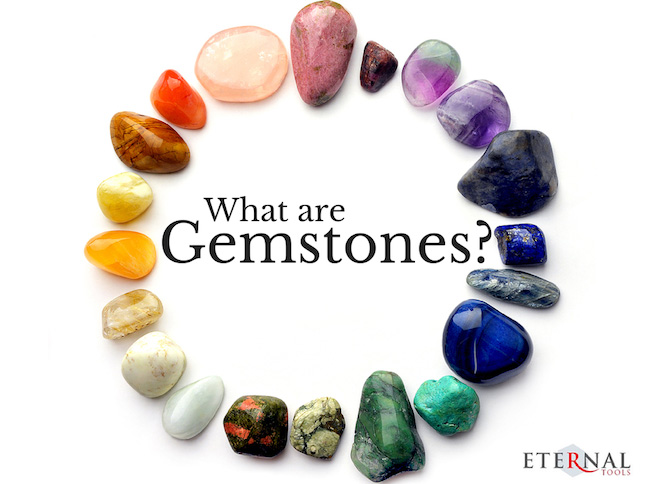A Guide to Gemstones: The Facts

A gemstone is the name given to a piece of mineral (or other rock or organic material) that after it has been cut and polished has been made into a piece of jewellery or another accessory.
Although gemstones are commonly made from minerals, materials such as jet or amber or rocks like lapis lazuli can also be utilised in the creation of gemstones.
The majority of gemstones will be hard to the touch but depending on the piece of jewellery that is being created, some soft minerals are also utilised. Take a look at the Mohs Scale of Hardness to find out more about this.
Some other names for a gemstone include:
- Gem / Fine Gem / Semi-precious gemstones
- Precious stone / Semi-precious stone
- Jewel
How Are Gemstones Formed?
Even though the vast majority of gemstones are created below the surface of the earth, there are a number of different ways that individual stones can be created. A great number of these precious stones are created when the minerals react with water that is found just below the surface of the earth and the minerals then dissolve. This process allows the minerals to form with gemstones like opals, agates and amethysts forming when the solution cools or evaporates.
Gems like malachite, azurite or turquoise are formed when water blends with rocks that are rich in copper. Since ancient times there has been a strong history attached to turquoise gems with the ancient Egyptians regarding them to be an extremely precious gem. This means that turquoise gems have been around for 4,000 years or even longer!
Value of Gemstones
Much the same as you would expect from any other major industry, the price of gemstones is largely influenced by supply and demand.
One of the most important things for people when considering gemstones is the value and price for them but like in many industries, the laws of supply and demand are very much in place. This means that rare gems will carry a higher price tag.
For instance, a garnet is extremely stylish and attractive but it is not that rare, which means that its price tag is not too high. If you compared a garnet to a ruby of a similar size and condition, the ruby would always hold a higher price, simply because of the fact that it is a rare stone.
It is often difficult to place a true value on any particular gemstone because there is no uniform classification or measurement system in place. This is where gemstones differ from diamonds, which have been subject to a uniform measurement system since the 1950s. Traditionally, gemstones have been examined and evaluated by eye. When examining a gemstone, the four most important factors can be summed up in the four C’s, which are; colour, clarity, cut and carat.
Even though diamonds are one of the most prized possessions on Earth, with yellow diamonds and red diamonds being highly sought after, there are actually a number of different gemstones that are rarer to find than diamonds. Some of the rarest gemstones you can find include:
- Painite
- Alexandrite
- Tanzanite
- Benitoite
- Poudretteite
- Grandiderite
- Musgravite
- Jeremejevite
- Red Beryl
Buying Gemstones
With gemstones being the focal point of so many great pieces of jewellery and important items such as an engagement ring, it is understandable why so many people are interested in buying them. However, it helps to know what you are doing and looking for when you shop for gemstones.
It goes without saying that you should only buy gemstones from respected firms or individuals. If a too-good-to-be- true deal for gemstones arises, it is likely to be too-good-to-be-true. The opportunity of making great savings when buying a gemstone is very tempting and this can lead people to look for bargains. However, in this case, there is a high chance that you may end up paying a high fee for a fake or synthetic gemstone.
When you are looking to buy a gemstone, you will find it much easier to buy a natural gemstone when it is a colour you are shopping for and not a particular type of stone. In this case, gemstones such as peridot, alexandrite or moonstone, which are not treated, are the better option to look for.
When buying gemstones, like any other major purchase, it pays to do your research in advance and to look around at various shops or outlets before making a purchase. If you are more interested in the look and design of a jewellery piece as opposed to its veracity of it, you may be better off buying a synthetic gemstone or items with semi-precious stones. Lab-created gemstones or Modern synthetic gemstones look just as good (sometimes with fewer blemishes) as traditional pieces.
The Different Colors of Gemstones
Shop around for the right colour when buying loose gemstones or set stones in jewellery pieces. Natural gemstones can appear in many different colors. Let’s take Yellow Sapphire for instance, this naturally appears in a whole range of beautiful colors from pale yellow, and green-yellow to vivid orange and everything in between. Blue Sapphire can be found as a pale baby blue colour to a rich royal blue. Blue Topaz can be found in the colours Sky Blue, Swiss Blue and my personal favourite: London Blue.
Optical Properties of Gemstones
Gemstones have always been a source of fascination for humans because of their optical properties. These precious stones can display a color change when they reflect or refract light, and this phenomenon is called dispersion.
Gemstones can also exhibit pleochroism, which means they show different colors when viewed from different angles. This property makes these stones look unique and beautiful.
Additionally, gemstones can be transparent, translucent, or opaque, which determines how much light passes through them. The clarity of a gemstone affects its value, and inclusions or impurities within different stones can affect its optical properties as well such as in a Fire Opal for instance. In conclusion, the optical properties of gemstones are what make them a popular choice for jewellery makers and make them so special and coveted by people all over the world.
What Are Organic Gemstones?
Organic gemstones come from living organisms, which makes them extra special because they carry the energy of life within them. Some popular organic gemstones include pearls, amber, and coral. These precious stones have been cherished for centuries due to their natural beauty and rarity. Unlike other gems that are mined from the earth, organic gemstones require careful cultivation and processing.
What Are Crystals?
Crystals can be found in all corners of our beautiful planet and come in a variety of shapes, sizes, and colours.
Unlike types of gemstones, crystals have a unique molecular crystal structure that allows them to hold energy and emit vibrations. Each crystal has its own special properties that make it perfect for different purposes such as healing, protection, and manifestation.
From amethysts to rose quartz, these stunning natural treasures have been revered for centuries for their beauty and metaphysical abilities.
Drilling, Cutting, Polishing and Carving Gemstones
For further tutorials and information, you might be interested to take a look at our easy step-by-step guide on How to Drill Gemstones.
To polish, carve, slice, cut and file your gemstones you will need to use diamond tools. We have a wide range of wheels, burrs, files, pastes, drill bits and laps, come and have a look at Eternal Tools Diamond Tools
Whether you’re looking to carve, wire wrap, set or drill your gemstones we hope here at Eternal Tools we can help you with the precision tools and lapidary tools you’ll need.
For detailed information and a list of gemstones and Popular Birthstones visit The International Gem Society’s website


